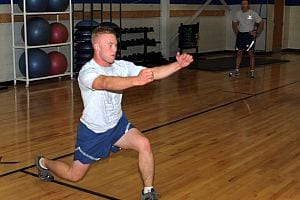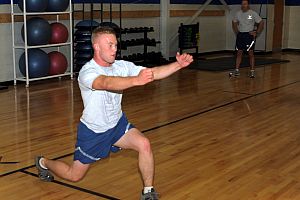statFor some women, it's about making an elegantement at special events or being a couple…

The Fitness Logic of Cross-Training
 There’s a very prevalent misconception in the amateur fitness logic ranks that mastering one type of exercise will result in whole-body fitness. An avid runner may think she’s reached the pinnacle of health, while a weight-trainer may believe he’s fit enough to do just about anything. However, this same runner may injure her shoulder while playing tennis or putting a heavy box on a high shelf. And that same weight-trainer may become winded after just a few seconds of running. These are both great illustrations of an important idea–exercise programs that emphasize only one or a small number of movements or activities will NOT lead to all-around fitness.
There’s a very prevalent misconception in the amateur fitness logic ranks that mastering one type of exercise will result in whole-body fitness. An avid runner may think she’s reached the pinnacle of health, while a weight-trainer may believe he’s fit enough to do just about anything. However, this same runner may injure her shoulder while playing tennis or putting a heavy box on a high shelf. And that same weight-trainer may become winded after just a few seconds of running. These are both great illustrations of an important idea–exercise programs that emphasize only one or a small number of movements or activities will NOT lead to all-around fitness.
All-around fitness actually has several dimensions. And while different experts may have slightly different lists, nearly all will include strength, endurance, flexibility, balance, speed and coordination. That’s where cross-training comes in. Cross-training is the practice of exercising not just certain sets of muscles over and over in the same way, but as many as possible through a variety of different activities.
So what exactly does cross-training do for you? Done effectively, cross-training can help you achieve a broader definition of fitness. It can also help prevent injuries that sometimes result from one-dimensional workout routines as well as longer-term patterns of over-use in some parts of the body and under-development in others. There’s also some evidence that cross-training helps reduce the likelihood and severity of performance setbacks or plateaus. Finally, cross-training helps keep things interesting!
The broader definition of fitness is all about challenging the body to push beyond its current level of performance in several areas so that it can progress through cycles of recovery and adaptation. Whether it’s the amount of weight being lifted, the distance being run, the range of motion in a stretch or the time to complete an agility course, the goal is to improve over time. For an athlete who focuses on one sport, cross training can mean just about anything other than that sport. For the fitness enthusiast, it usually means using many different activities to ensure total fitness–typically with a dual focus on cardiovascular fitness and strength training.
Cross training reduces the risk of musculoskeletal injuries by distributing the total amount of orthopedic strain and impact over a broader group of muscles and joints. This means that cross-trainers can work out more frequently and for longer durations without significantly overworking specific areas of the body that are especially vulnerable, such as the knees, hips, back, shoulders, elbows, and feet. By performing a wider range of activities, cross-trainers also condition parts of the body that might otherwise remain relatively underdeveloped and more susceptible to injury. For example, long-distance runners (who are particularly at-risk of lower-leg problems) might consider integrating low-impact exercises such as elliptical training, cycling, and swimming into their workouts.
Those looking to lose weight also have a very good reason to participate in cross-training programs. For them, it’s vital to be able to perform activities that burn a substantial number of calories over a sustained period without injury. Studies have shown that weight loss goals are most attainable when individuals work out for moderately long lengths of time (that is, over 30 minutes) at a moderate level of intensity. Since people who are overweight place relatively greater strain on muscles and joints, distributing the stress and impact of this exercise more broadly is particularly important. Overweight exercisers can successfully reduce body weight and fat stores by performing two or more exercises in a cross-training program. For example, exercising on an elliptical for about 30 minutes, then cycling for an extra 20 to 30 minutes is a great way to burn calories efficiently.
While diligent cross-training can reduce the risk of getting hurt, we should mention that even this sort of exercise program can result in overuse injuries if the athlete doesn’t allow for sufficient rest and recovery, maintains an uneven exercise schedule or has poor form.
When it comes to sustaining interest and motivation, it’s hard to argue against cross-training. A great deal of research suggests that injury and boredom (not necessarily in that order) are two of the leading reasons why people stop working out. Cross-training is a safe and comparatively stress-free way to add variation to an exercise regimen, thus reducing the likelihood of both injury and boredom.
So how does a would-be cross-trainer get started? There are a multitude of exercises to try out. From AceFitness.org: “The essential fundamentals of cross training are the same whether you are exercising for improved health and fitness or for competition. Try varying your exercise program from workout to workout by engaging in different types of activities, or simply add a new form of exercise (e.g., resistance training, Pilates, a boot-camp class) to your existing workout routine.”
Lastly, give yoga, swimming, and hiking a try, and be creative—you never know what new way to work out may thrill you!




